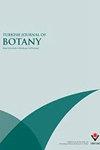伊朗部分车前草(车前草科)种种子形态及其系统发育意义
IF 1.5
4区 生物学
Q3 PLANT SCIENCES
引用次数: 0
摘要
:Plantago是一个世界性的属,约有200种,已报道了各种亚属分类。在本研究中,使用扫描电子显微镜和光学显微镜对来自伊朗的19种车前草的种子形态进行了详细的研究和记录。通过使用统计分析,如基于欧几里得距离的最小球面聚类方法、主坐标分析和多维尺度,对研究物种进行分组。根据所研究种子的形状和内侧状态,我们描述了四种类型:凸角型、凸椭圆型、平椭圆型和凹椭圆型。在这项研究中,识别出三种类型的种皮图案:网状、梯状到网状和乳头状。无论考虑的分类群范围有限,我们的数据都令人信服地支持Plantago亚属和Coronopus之间以及Albicans和Psylium之间的密切关系。因此,我们建议将Coronopus亚属的物种作为Pilger的分类法放在Plantago亚属中,而Albicans亚属的种类应该作为Rønsted等人的分类法合并在Psylium亚属中。种子形态表明,车前子亚属和合欢子亚属为副系。此外,种皮细胞的变形可以作为在亚属水平上寻找不同谱系的指标。种皮细胞和背斜壁排列的特征可以在物种水平上使用,特别是当物种之间的形态多样性较低时。我们认为,种子形态为Plantago物种的系统发育关系提供了有用和重要的信息,因此具有系统意义。本文章由计算机程序翻译,如有差异,请以英文原文为准。
Seed morphology of some Plantago (Plantaginaceae) species in Iran and its systematic and phylogenetic implications
: Plantago is a cosmopolitan genus with approximately 200 species and various infrageneric classifications have been reported. In this study, the seed morphologies of 19 species of Plantago from Iran were studied and documented in detail using scanning electron microscopy and light microscopy. The studied species were grouped by using statistical analyses such as a minimum spherical cluster method based on Euclidean distance, principal coordinate analysis, and multidimentional scaling. We have described four types based on the seed shape and states of the inner side of the studied seeds: convex-angular type, convex-elliptic type, flat-elliptic type, and concave-elliptic type. In this study, three types of seed coat patterns were recognized: reticulate, scalariform to reticulate, and papillate. Regardless of the limited range taxa considered, our data convincingly support a close relationship between subgenera Plantago and Coronopus , and between Albicans and Psyllium . Consequently, we would suggest that the species of subgenus Coronopus should be placed within subgenus Plantago as Pilger’s taxonomy, and the species of subgenus Albicans should be merged within subgenus Psyllium as Rønsted et al.’s taxonomy. The seed morphology revealed that subgenus Plantago and subgenus Albicans are paraphyletic. Moreover, the deformation of testa cells can be an indicator for finding different lineages at series to the subgenus level. The features of the arrangement of testa cells and anticlinal walls can be used at the species level, especially when the morphological diversity between species is low. We conclude that seed morphology provides useful and important information on phylogenetic relationships of Plantago species, and thus they have systematic significance.
求助全文
通过发布文献求助,成功后即可免费获取论文全文。
去求助
来源期刊

Turkish Journal of Botany
PLANT SCIENCES-
CiteScore
2.90
自引率
5.60%
发文量
31
审稿时长
6-12 weeks
期刊介绍:
The Turkish Journal of Botany is published electronically 6 times a year by the Scientific and Technological Research Council of Turkey (TÜBİTAK) and accepts manuscripts (in English) covering all areas of plant biology (including genetics, evolution, systematics, structure, function, development, diversity, conservation biology, biogeography, paleobotany, ontogeny, functional morphology, ecology, reproductive biology, and pollination biology), all levels of organisation (molecular to ecosystem), and all plant groups and allied organisms (algae, fungi, and lichens). Authors are required to frame their research questions and discuss their results in terms of major questions in plant biology. In general, papers that are too narrowly focused, purely descriptive, or broad surveys, or that contain only preliminary data or natural history, will not be considered (*).
The following types of article will be considered:
1. Research articles: Original research in various fields of botany will be evaluated as research articles.
2. Research notes: These include articles such as preliminary notes on a study or manuscripts on the morphological, anatomical, cytological, physiological, biochemical, and other properties of plant, algae, lichen and fungi species.
3. Reviews: Reviews of recent developments, improvements, discoveries, and ideas in various fields of botany.
4. Letters to the editor: These include opinions, comments relating to the publishing policy of the Turkish Journal of Botany, news, and suggestions. Letters should not exceed one journal page.
(*) 1. Raw floristic lists (of algae, lichens, fungi, or plants), species descriptions, chorological studies, and plant sociology studies without any additional independent approaches.
2. Comparative morphology and anatomy studies (that do not cover a family, tribe, subtribe, genus, subgenus, section, subsection, or species complexes with taxonomical problems) without one or more independent additional approaches such as phylogenetical, micromorphological, chromosomal and anatomical analyses.
3. Revisions of family, tribe, genus, subgenus, section, subsection, or species complexes without any original outputs such as taxonomical status changes, IUCN categories, and phenological and ecological analyses.
4. New taxa of all plants without any additional independent approaches such as phylogenetical, ecological, chromosomal, chorological and correlational analyses in addition to a detailed macro- and micro-morphological descriptions with quality field and microscopic illustrations of taxonomically important structures and identification key in the taxonomic group.
New records of all plants without any additional independent approaches such as phylogenetical, ecological, chromosomal, chorological and correlational analyses in addition to a detailed macro- and micro-morphological descriptions with quality field and microscopic illustrations of taxonomically important structures and identification key in the taxonomic group may be accepted for peer review if they contain 3 or more new records or taxonomical status update, such as lectotypification, new combinations, transfers, revivals and synonyms.
5. New taxa of algae, lichens, and fungi without any additional independent approaches such as phylogenetical, ecological, chromosomal, chorological and correlational analyses in addition to a detailed macro- and micro-morphological descriptions with quality field and microscopic illustrations of taxonomically important structures and identification key in the taxonomic group.
New records of algae, lichens, and fungi without any additional independent approaches such as phylogenetical, ecological, chromosomal, chorological and correlational analyses in addition to a detailed macro- and micro-morphological descriptions with quality field and microscopic illustrations of taxonomically important structures and identification key in the taxonomic group may be accepted for peer review if they contain 5 or more new records or taxonomical status update, such as lectotypification, new combinations, transfers, revivals and synonyms.
 求助内容:
求助内容: 应助结果提醒方式:
应助结果提醒方式:


